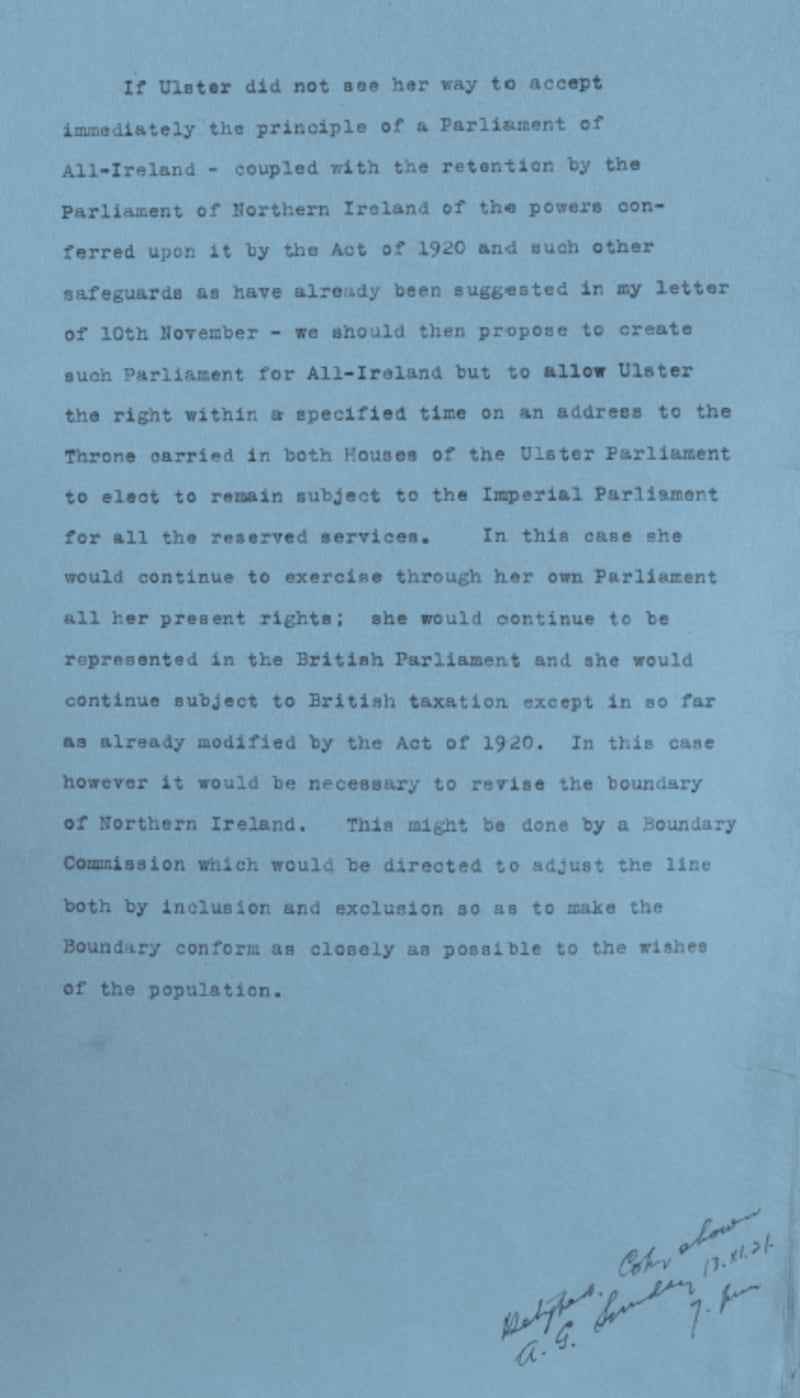For the last 100 years, the behaviour of British prime minister David Lloyd George at the end of the Anglo-Irish Treaty negotiations has been the subject of much speculation and controversy.
The Welsh Wizard, as he was known, was a skilled negotiator who could use bluff, flattery and coercion in equal measure to get his way.
On the dramatic night of December 5th, 1921, Lloyd George pressed the Irish delegation to sign. With a characteristic flourish he produced a document seeming to suggest that he and Arthur Griffith, the head of the Irish delegation, had agreed in November to a Boundary Commission.
It would decide what parts of Ulster would join the Irish Free State or Northern Ireland.
Lloyd George presented the Irish with a page that Griffith had been shown in November.
The inference was that the pair agreed a secret pact about the fate of Northern Ireland behind the backs of the Irish delegation and that Griffith was honour bound to sign the Treaty.

However, Griffith's biographer Professor Colum Kenny said he had identified in the past month the original text by Lloyd George and that it proves Griffith did not conspire in secret with the prime minister.
“The perception is that this was some kind of a cunning document to trap Griffith for Lloyd George. There is no basis to that,” he said.
"Finding the original document shows that this was just part of the discussions that took place all week long that were reported to de Valera. "
The document, part of a long memo by British official Lionel Curtis, is among archives in the Lloyd George papers in Westminster (LG/F/181/4). It features in an article written by Prof Kenny for The Irish Times 1921 Century supplement Truce and Treaty.
It corresponds word-for-word with a note that Treaty delegate Robert Barton made of Lloyd George's document on that night.
The memo deals with the fate of Northern Ireland and whether or not it should participate in an all-Ireland parliament.
Griffith agreed not to repudiate the document before a Conservative Party conference happening in Liverpool a week later and told de Valera he had done so. Tory support was critical to the outcome of the Treaty.
Border Commission
Griffith wanted a plebiscite which the Irish delegation anticipated would hand over the counties of Fermanagh and Tyrone along with Derry city and south Armagh to the Free State, making Northern Ireland unviable. But he and Michael Collins believed, naively as it turned out, that a Border Commission would amount to the same thing.
The memo stated that Northern Ireland could opt out of an all-Ireland parliament, but it would be subject to increased taxation. Critically it would also be “necessary to revise the boundary of Northern Ireland”. This is a much stronger wording than was contained in the eventual Treaty.
The contents of the memorandum were included in the draft of a letter intended to be sent to the Northern Ireland prime minister Sir James Craig, but not in the letter as sent. Griffith briefed de Valera on the matter at least four times that week.
The final typed-up page was shown to Griffith on November 13th, 1921, as noted on it by UK assistant cabinet secretary Thomas Jones.
Prof Kenny said allegations of secret dealings was down to Frank Pakenham’s book Peace by Ordeal which was published in 1935 and still influences historians today.
Prof Kenny said the wording of the document showed the British government took a tougher line with the unionists than they did after the Treaty was signed.
He believed the Irish delegation, at the promptings of de Valera, spent too much time on the wording of the Oath of Allegiance and not enough time on the commission.
The eventual Article 12 of the Anglo-Irish Treaty allowed for a three-person Boundary Commission, but when it reported in 1925 it only allowed for a modest exchange of territory between the two jurisdictions. Its recommendations were scrapped and the Border remains in place to this day.
The 1921 Century supplement, Truce and Treaty, is published on Tuesday, May 25th.








